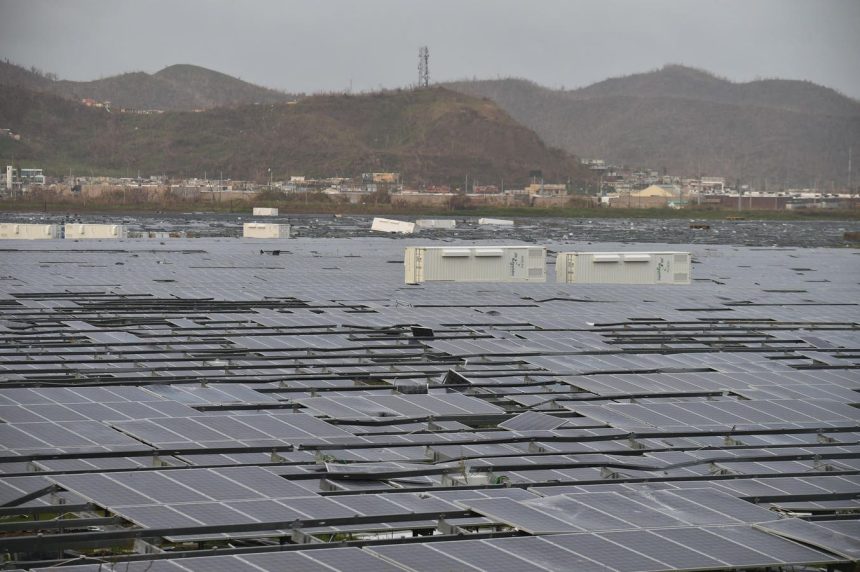Renewable energy is a key part of reducing the human impact on the climate, but extreme weather, some of which is increasingly severe in a changing climate, threatens the nascent energy transition. Storm-related equipment damage and business disruption present major threats to energy conversion and reaching consensus sustainability goals.
For example, a 3,300-acre solar farm that serves more than 60,000 homes was caught in a March hailstorm that seriously damaged thousands of its photovoltaic (PV) panels. There was another hailstorm in 2019 in West Texas that cost insurers an estimated US$70 million to US$80 million in damage. There have been a number of other hail events costing insurers millions of dollars in several states.
Hail risk looms large
Hail is an outsized threat to renewable energy. Hail-related claims average $58.4 million and account for more than half of the incurred cost of PV solar loss claims. Storms will continue to challenge the viability of solar energy, since hail maps show that the region with the greatest severity overlaps much of the same central region of the U.S. that has the greatest potential for solar energy. See the solar irradiance map from the National Renewable Energy Laboratory, below.
There are other threats to the energy transition. Solar farms, as well as wind farms and energy storage facilities, are also vulnerable to wind, including hurricanes and tornadoes, as well as wildfire, flood, electrical fire and equipment failure.
Losses frequently outstrip insurance coverage, and total exposure is outstripping total insurance capacity. This trend is putting the renewable energy industry on an unsustainable path toward uninsurability. It’s a similar financial dynamic to the one prompting residential property insurers to pull out of wildfire- and hurricane-prone states.
Equipment quality at issue
Investors have been squeezed by startup costs that incent them to cut corners and buy inexpensive, lower-quality equipment. One report found that underperformance from equipment faults and related issues accounts for an estimated $4.6B in annual revenue loss for the solar power generation industry worldwide.
These disruptions affect not only short-term potentially insured revenue but also long-term financial destiny by reducing market share and future growth opportunities. Hence, energy producers, their investors and those that rely on energy from these sources are also accepting levels of risk that are not viable to maintain into the future.
At present, future insurance options are to make coverage much more expensive, or to withdraw coverage for the industry, both of which pose roadblocks that will slow energy transition (which is already behind schedule in the context of consensus climate goals).
Ultimately, renewable energy systems have to be well-engineered and reliable as well as robust against damage caused by the same hazards that they are aiming to mitigate via reduction in greenhouse gas emissions. Specifically, industry leaders need to do for renewable energy systems what’s been done for air travel – proactively engineer the risk out of renewable energy projects. And it needs to be done from the planning stages.
How to support the energy transition
The solution framework includes:
- A flight to quality favoring less vulnerable renewable energy products and systems. The basic vulnerabilities of PV solar panels, structural and electrical systems, and wind turbine towers, turbine blades and equipment are fairly well known. Equipment reliability and durability need to become the requirements for designers, financiers and operators rather than the present drive to reduce cost.
- Industry certification for product robustness and quality control as well as performance criteria for energy output. For example, ANSI FM 4476, ANSI FM 4478 and FM 4480 certify performance for damage from hail, fire spread and wind.
- Adoption and enforcement of standards for designing, manufacturing, installing, operating, monitoring, integrating and decommissioning renewable-energy facilities. These need to be fast-tracked to keep up with innovation in a rapidly changing industry and scaled to cover installations in areas not typically associated with these types of businesses (for example, a rural area that now hosts a utility-scale PV solar facility).
Having learned the hard way, insurers now need to turn the page, promote these resilience measures and, in this way, do their part to lead a sustainable renewable energy transition. Enduring change will require a longer-term view backed by upfront investment. Quality improvement efforts should coincide with initiatives to reduce offshoring of PV panel manufacturing.
Improving products and operations should help ensure the viability of a currently fragile industry and protect the environment by putting the world back on track toward climate goals. A successful, timely transition is necessary for preventing the worst effects of climate change. Now is the time to demand quality that will stand up to the same hazards posed by Mother Nature that sustainable energy is trying to mitigate. The research is mounting, and the expertise is largely in hand. Now is the time to put them into practice.
Read the full article here














